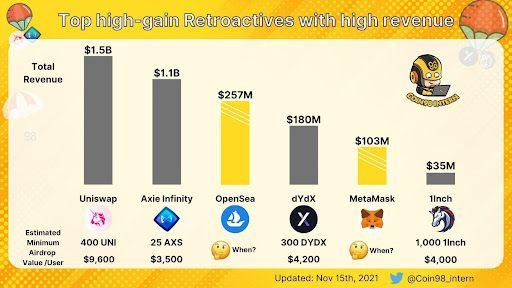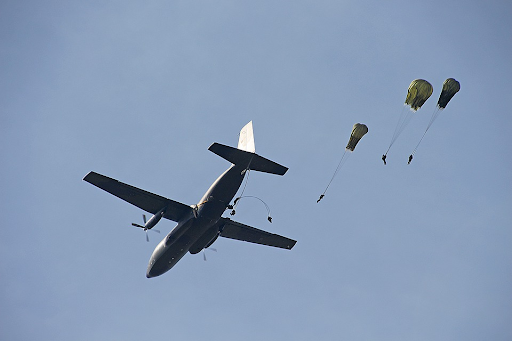What Are Airdrops?
Airdrops are the mainstay of crypto adoption. Free and low-effort, developers rely on token airdrops to attract new users to their DeFi protocols (and even crypto projects). Sometimes, competitive protocols become the target of airdrops as well, as it happened between 1inch and Uniswap decentralized exchanges (DEXes).
For those reasons, airdrop-tracking has become a niche in itself, with many aggregator websites to notify of upcoming airdrop opportunities. Before we delve into airdrop innovation and aggregation, let's first explain airdrops in greater detail.
Airdrops explained
The term "airdrop" itself stems from World War II, when cargo airplanes dropped vital supplies to both beleaguered civilians and soldiers. In the blockchain world, airdrops are types of marketing campaigns. The purpose of any marketing activity is to draw in new customers to a specific product.
Airdrops accomplish this by making crypto communities aware of new blockchain projects. Of course, they tend to have tokens to govern and fund the new crypto networks. Therefore, when we talk of airdrops, we talk of token airdrops distributed into people's crypto wallet addresses. To become eligible for such drops, it is common for the adopters to engage in:
- Retweeting
- Subscribing
- Link-sharing
- Commenting
- Registering
- Using a protocol
- Referring
These are all default micro-tasks that airdrops demand in exchange for free tokens. Most often, they are conducted across social networks and messengers: Twitter, Facebook, Telegram, Instagram, and even Ethereum address submissions. However, in the early days of cryptocurrencies, airdrops were largely free. Some of the biggest ones were:
- Oyster (PRL): From November 2017 to January 1, 2018, $9.7 million worth of 2227 PRL tokens were distributed to people who had accounts on airdropalert.com.
- Stellar (XLM): After June 2017, $124 million worth of XLM tokens were poised for airdrops, or 1000 XLM for every 1 BTC holder registered.
- Minereum (MNE): In January 2016, 32,000 worth $448k were airdropped.
- Decred (DCR): On April 25, 2018, $36 million worth of 258k DCR was given away.
Last year, we saw a new novelty — NFTs — being airdropped alongside standard fungible tokens. Play-to-earn (P2E) games such as Radio Caca (RACA) and GoldMiner (GM) were among the prominent NFT airdrops. Of course, Decentralized Finance (DeFi) tokens are still the most popular. For instance, DeFiScale rewarded 1,009 adopters with $40 worth of DFC tokens.
Those who were at the top of their referral game could have earned between $35–$1,500 each. Not only could those airdropped tokens be exchanged for real money on a crypto exchange, but holders could simply wait for tokens to appreciate in value as the protocol gains popularity.
In the end, this is what token airdrops are all about, gaining the chance to own digital assets which could go up to 100x in ROI (return on investment). Except, outside of micro-tasks, the investment is free. Speaking of ROI, there are also retroactive airdrops to consider.
Retroactive airdrops reward loyalty
For people who believe in the fundamentals of a particular blockchain project, they have a chance to be rewarded after the fact. More precisely, if they have in some way interacted with the protocol's tokens/wallet in a specified period of time. Because of this, retroactive airdrops are reserved for more experienced, veteran crypto enthusiasts.
Commonly, they are diversified across AMM/DEX (automated market maker/decentralized exchange), borrowing, lending, infrastructure, oracles (projects that feed off-chain data to on-chain networks). So far, those who have had transactions under their belt, have seen millions worth of tokens dished out.

As you can see, the list is dominated by the biggest DEX Uniswap, its competitors dYdX and 1inch, and the most successful blockchain game Axie Infinity. Interestingly, Axie Infinity is also its own NFT marketplace with a total trading volume of nearly $4billion, just after OpenSea at $14.7 billion.
Most recently, OpenDAO used OpenSea's NFT market dominance to airdrop its SOS tokens on Christmas. SOS is the native token of OpenDAO, giving users voting rights on building decentralized autonomous organization (DAO) for Web3-based metaverse. SOS tokens number at 100 trillion, and 50% of that massive supply was airdropped to OpenSea users. That is, those who took part in trading NFTs.
OpenDAO airdrop is especially worthy of note because it innovates the space in two ways. First, the tokens issued were distributed on a third-party platform — OpenSea. Second, they were airdropped to compensate scam victims and to bolster newcomer artists. The first part is more important, and it may set a new trend. Because Ethereum is a public blockchain, anyone has access to its smart contracts, which made OpenDAO's SOS token airdrop possible.
Where to find airdrops?
The best way to monitor token airdrops still remains the same. We have already mentioned AirDropAlert.com, featuring one of the largest databases that also includes expired airdrops. Next is Airdrops.io, an airdrop aggregator featuring detailed requirements a user must do to successfully become eligible.
Lastly, there is the more curated BountiesAlert.com, monitoring exclusive, ongoing airdrop campaigns. To avoid scams, one should not venture too far off these platforms. Furthermore, always make sure to verify a drop across multiple platforms and the team behind it. If you see that an airdrop requires you to send some tokens of your own first, even in negligible value, you are 100% encountering a scam.
Rahul owns less than 1 BTC and 40 LRC.
International Business Times holds no liability for any investments made based on the information provided on this page. We strongly recommend independent research and/or consultation with a qualified professional before making any investment decisions.

© Copyright IBTimes 2025. All rights reserved.





















